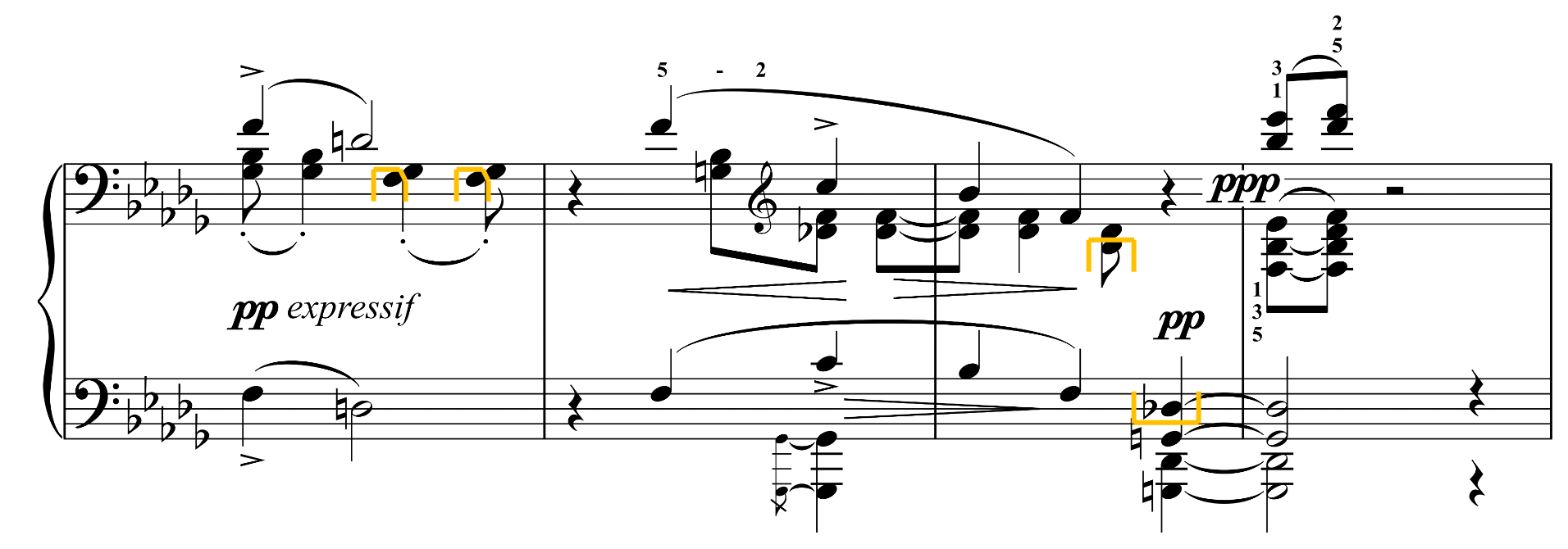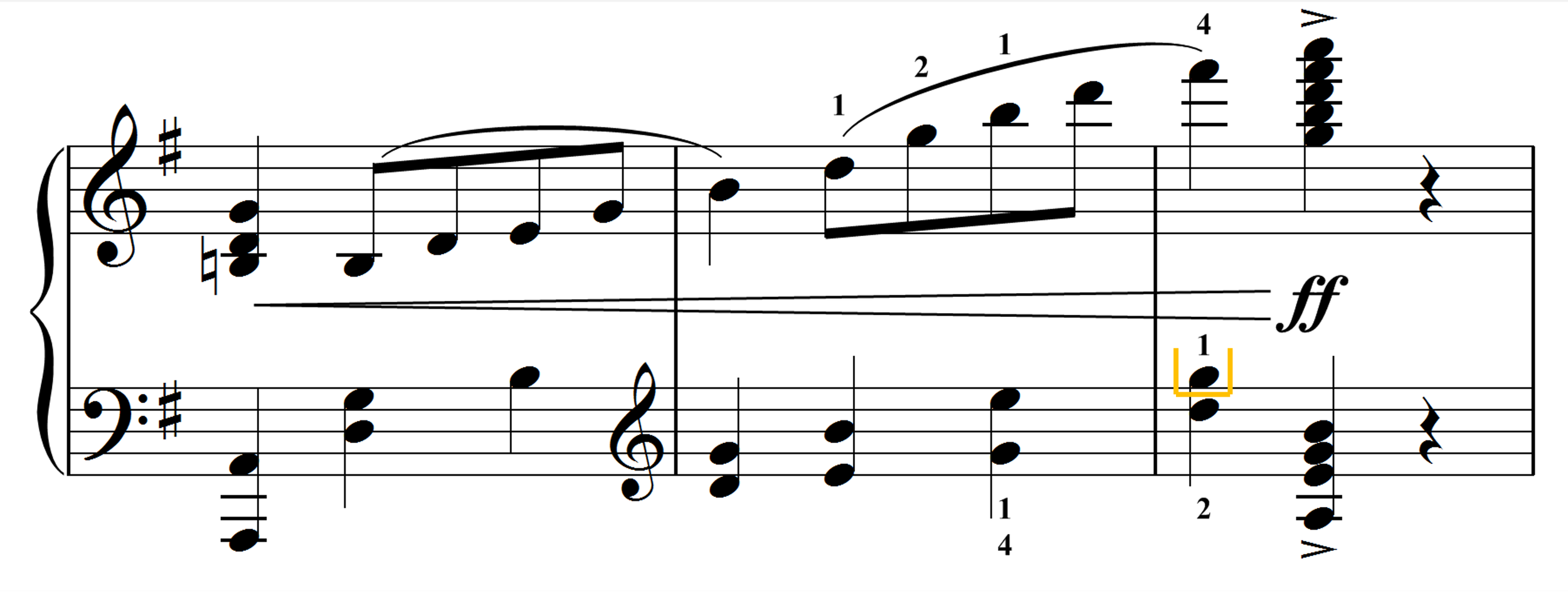“The B-flat eighth note evenly divides the left-hand leap, and I find it easier to play it between the E-flat octaves in the left hand than with the right hand.”
Submitted by Michael Clark
Published on 1/1/2020

“The B-flat eighth note evenly divides the left-hand leap, and I find it easier to play it between the E-flat octaves in the left hand than with the right hand.”
Submitted by Michael Clark
Published on 1/1/2020

“The right-hand thumb is already position on the E-flat. This fingering reduces position shifts and allows for smaller hands to play all the notes of the final chord simultaneously.”
Submitted by Michael Clark
Published on 5/24/2023

“These notes fall naturally into the left hand’s position.”
Submitted by Michael Clark
Published on 9/3/2023

“The F falls easily within the right hand’s position—taking it with the right hand saves the left hand from reaching quite as far across the body.”
Submitted by Michael Clark
Published on 11/22/2023

SPECIAL COLLECTION | Dorothy Brandwein’s Ravel Fingerings
Published on 4/19/2022 with the author’s permission
First appeared in Dorothy Woster Brandwein, "Divisi Fingering in Selected Passages from Ravel's Solo Piano Works" (DMA diss., University of Missouri–Kansas City, 1981), 26, 74.
25–26: “The left hand figuration in the measures of Example 5 is difficult because of its register, its location on the black keys, and the marked accents of the counter-melody. The right hand can conveniently play some of the notes in the figuration, and, in this way, contribute to the rhythmic momentum of the passage.”

SPECIAL COLLECTION | Dorothy Brandwein’s Ravel Fingerings
Published on 4/22/2022 with the author’s permission
First appeared in Dorothy Woster Brandwein, "Divisi Fingering in Selected Passages from Ravel's Solo Piano Works" (DMA diss., University of Missouri–Kansas City, 1981), 79.

“Taking the B-flat in the left hand eliminates a position shift. I like the voicing created by this redistribution of the diminished fifth.”
Submitted by Michael Clark
Published on 1/10/2020

SPECIAL COLLECTION | Dorothy Brandwein’s Ravel Fingerings
Published on 4/25/2022 with the author’s permission
First appeared in Dorothy Woster Brandwein, "Divisi Fingering in Selected Passages from Ravel's Solo Piano Works" (DMA diss., University of Missouri–Kansas City, 1981), 39, 81.
39: “Example 21 further illustrates the advantage of redistributing a single or recurring note in a passage, whereby the momentum is maintained with a more comfortable fingering.”

SPECIAL COLLECTION | Dorothy Brandwein’s Ravel Fingerings
Published on 4/28/2022 with the author’s permission
First appeared in Dorothy Woster Brandwein, "Divisi Fingering in Selected Passages from Ravel's Solo Piano Works" (DMA diss., University of Missouri–Kansas City, 1981), 98.

SPECIAL COLLECTION | Dorothy Brandwein’s Ravel Fingerings
Published on 4/29/2022 with the author’s permission
First appeared in Dorothy Woster Brandwein, "Divisi Fingering in Selected Passages from Ravel's Solo Piano Works" (DMA diss., University of Missouri–Kansas City, 1981), 99.

SPECIAL COLLECTION | Dorothy Brandwein’s Ravel Fingerings
Published on 4/29/2022 with the author’s permission
First appeared in Dorothy Woster Brandwein, "Divisi Fingering in Selected Passages from Ravel's Solo Piano Works" (DMA diss., University of Missouri–Kansas City, 1981), 99.

SPECIAL COLLECTION | Dorothy Brandwein’s Ravel Fingerings
Published on 4/29/2022 with the author’s permission
First appeared in Dorothy Woster Brandwein, "Divisi Fingering in Selected Passages from Ravel's Solo Piano Works" (DMA diss., University of Missouri–Kansas City, 1981), 101.

SPECIAL COLLECTION | Dorothy Brandwein’s Ravel Fingerings
Published on 4/30/2022 with the author’s permission
First appeared in Dorothy Woster Brandwein, "Divisi Fingering in Selected Passages from Ravel's Solo Piano Works" (DMA diss., University of Missouri–Kansas City, 1981), 103.

SPECIAL COLLECTION | Dorothy Brandwein’s Ravel Fingerings
Published on 4/4/2022 with the author’s permission
First appeared in Dorothy Woster Brandwein, "Divisi Fingering in Selected Passages from Ravel's Solo Piano Works" (DMA diss., University of Missouri–Kansas City, 1981), 107.

“The upper line has descended so low by this point that I find it easier to take a few notes in the left hand, giving the right hand a small break and the chance to adjust positions.”
Submitted by Michael Clark
Published on 8/5/2021